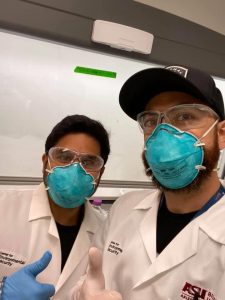Traces of Chemicals From Plastic Previously Found in All 47 Human Tissue Samples Surveyed. New Validated Method Will Allow for Wider Testing.
Plastic is everywhere and this seems to be common knowledge these days. It’s all over our grocery stores, in our food deliveries, all throughout the oceans, come to think of it, it’s actually hard to find an ecosystem or community that isn’t riddled with plastic waste. What remains a mystery is if plastic is making its way in our bodies.
We know that microplastics, which are small plastics less than 5mm, have been found in many organisms, from tiny zooplankton1 to large whales2, and many species in between that we consume. Bivalves, or shelled mollusks, are of particular concern as we consume them whole, including the stomach contents. Studies have shown oysters literally on their way to a restaurant, to have microplastics in their stomachs3. Other exposure routes exist as well. Ambient, plastic fibers in the air can make their way into our lungs4. Microplastics have also been discovered in table salt, beer, honey and sugar5.
The question remains, are they in our bodies and if so, where? One study that was done in our lab at Arizona State University (ASU) found traces of chemicals from plastic in all 47 human tissue samples they surveyed6. The next step? To see if there are actual plastic particles in our body.

ASU researchers, Charlie Rolsky and Varun Kelkar
In collaboration with Plastic Oceans International and the Banner Sun Health Research Institute (BSHRI) Brain and Body Donation Program, Varun Kelkar, Rolf Halden, and I created a method in ASU’s Biodesign Center for Environmental Health Engineering, to explore human tissue for the presence of microplastics. Using liver from a cow, we spiked the tissue with a known amount of tiny, plastic microbeads. We then dissolve the tissue using a strong acid, filter the contents and subject the remaining materials to a flow cytometer, which is able to count any foreign contaminants extracted from the sample. Our data show that this new method is capable of recovering and identifying microplastics spiked into human tissues. The developed method is quick, robust and scalable to handle large amounts of tissues.
We know that when a foreign entity enters our body, its natural response is to find it and remove it. That progression can bring about processes such as inflammation, which can also lead to more severe health effects. Plastics have been demonstrated to negatively affect the environment as well as the organism within and we would expect a similar situation if plastics are becoming sequestered in our tissues and organs.
This new technique is an exciting advancement towards a better understanding of the direct impact that plastics might have on our bodies. Our method will be a platform for researchers all over the world to access and build upon. Our initial results are being presented at the 2020 American Chemical Society Virtual Conference on August 17th.
(1) Cole, M.; Lindeque, P.; Fileman, E.; Halsband, C.; Goodhead, R.; Moger, J.; Galloway, T. S. Microplastic Ingestion by Zooplankton. Environ. Sci. Technol. 2013, 47 (12), 6646–6655. https://doi.org/10.1021/es400663f.
(2) Lusher, A. L.; Hernandez-Milian, G.; O’Brien, J.; Berrow, S.; O’Connor, I.; Officer, R. Microplastic and Macroplastic Ingestion by a Deep Diving, Oceanic Cetacean: The True’s Beaked Whale Mesoplodon Mirus. Environ. Pollut. 2015, 199, 185–191. https://doi.org/10.1016/j.envpol.2015.01.023.
(3) Van Cauwenberghe, L.; Janssen, C. Microplastics in Bivalves Cultured for Human Consumption. Environ. Pollut. Barking Essex 1987 2014, 193C, 65–70. https://doi.org/10.1016/j.envpol.2014.06.010.
(4) Tunahan Kaya, A.; Yurtsever, M.; Çiftçi Bayraktar, S. Ubiquitous Exposure to Microfiber Pollution in the Air. Eur. Phys. J. Plus 2018, 133 (11), 488. https://doi.org/10.1140/epjp/i2018-12372-7.
(5) Rainieri, S.; Barranco, A. Microplastics, a Food Safety Issue? Trends Food Sci. Technol. 2019, 84, 55–57. https://doi.org/10.1016/j.tifs.2018.12.009.
(6) Manivannan, B.; Yegambaram, M.; Supowit, S.; Beach, T. G.; Halden, R. U. Assessment of Persistent, Bioaccumulative and Toxic Organic Environmental Pollutants in Liver and Adipose Tissue of Alzheimer’s Disease Patients and Age-Matched Controls. Curr. Alzheimer Res. 2019, 16 (11), 1039–1049. https://doi.org/10.2174/1567205016666191010114744.
Charlie Rolsky is Director of Science, North America, for Plastic Oceans International. He is also the host of “Breaking It Down, With Charlie Rolsky” – a new YouTube series from Plastic Oceans that simplifies the science, while having a bit of fun. He conducts research at Arizona State University’s (ASU) Biodesign Center for Environmental Health Engineering where he works on marine and aquatic plastic pollution, a major concern within many ecosystems and environments around the world.

Trackback: คู่มือแทงหวย LSM99
Trackback: xxxโอลี่แฟน